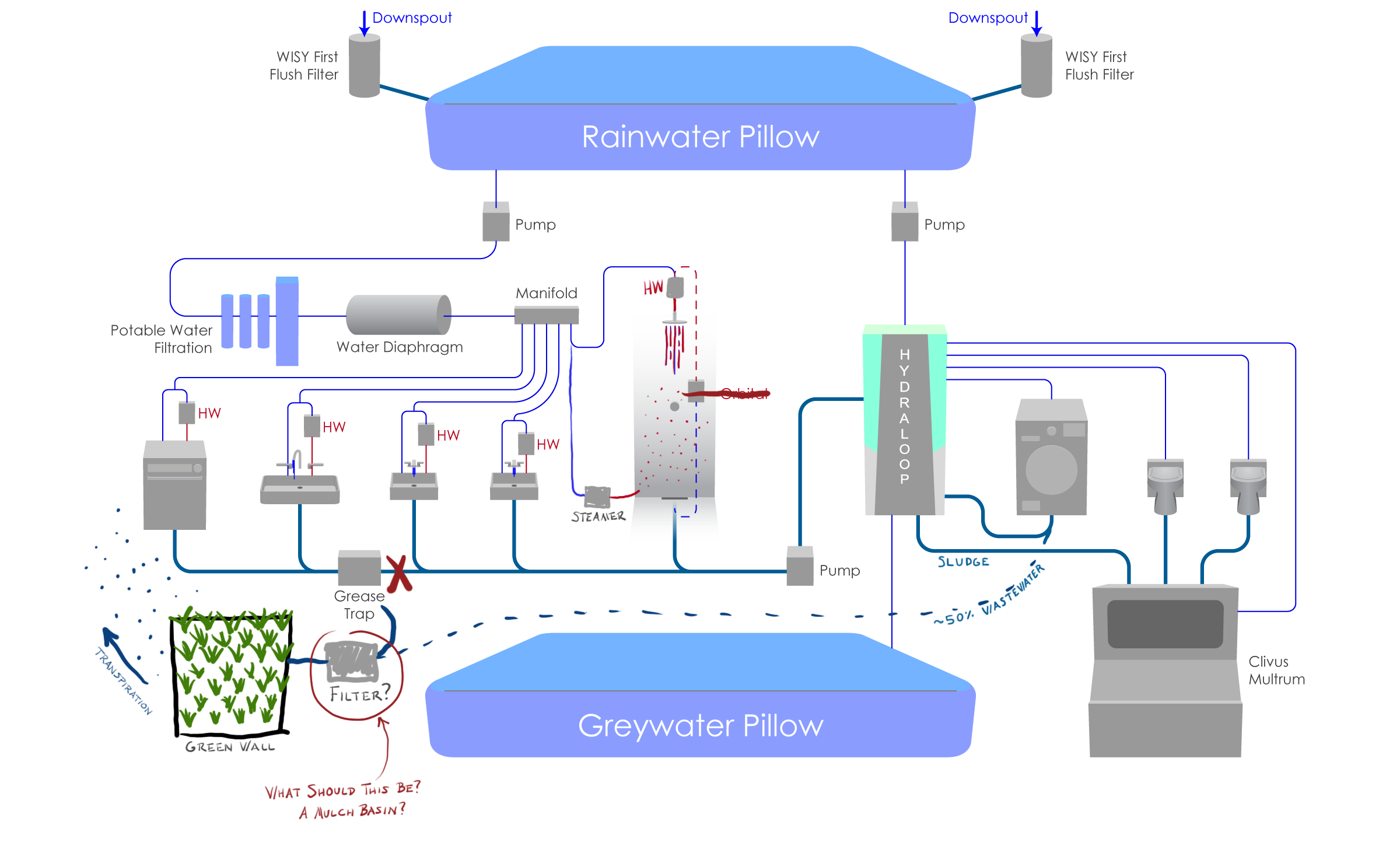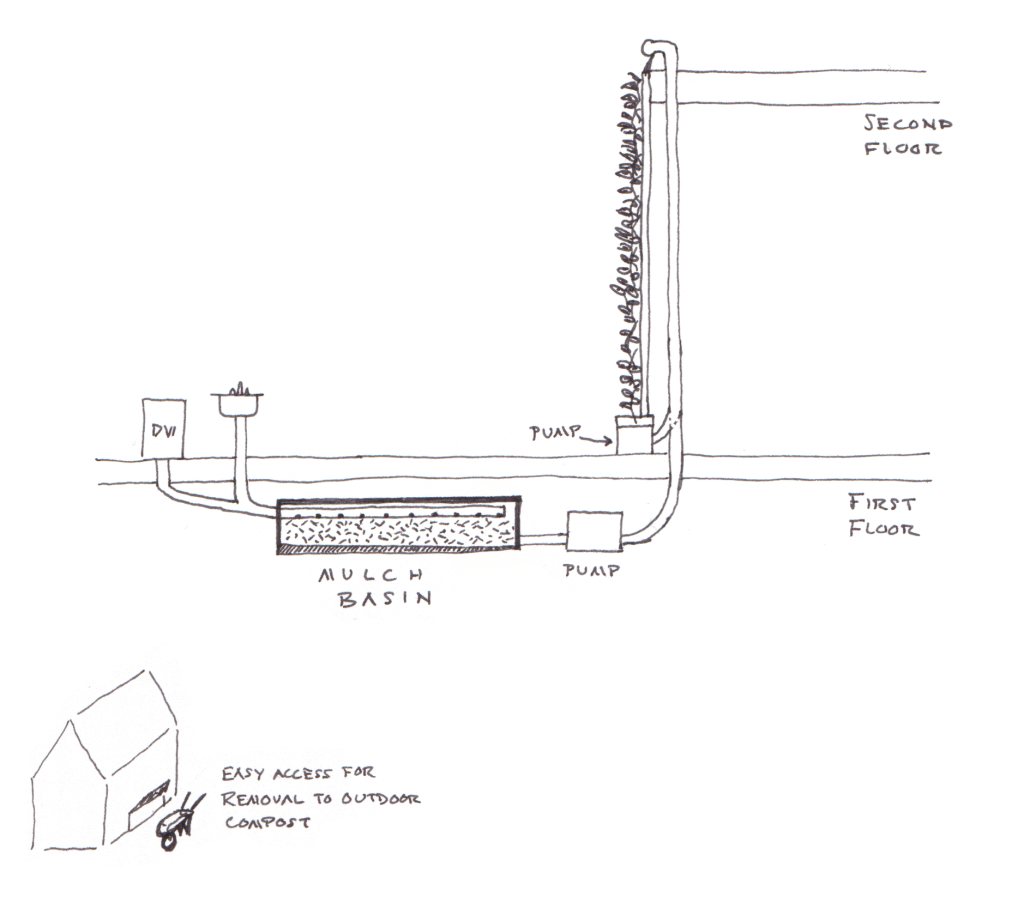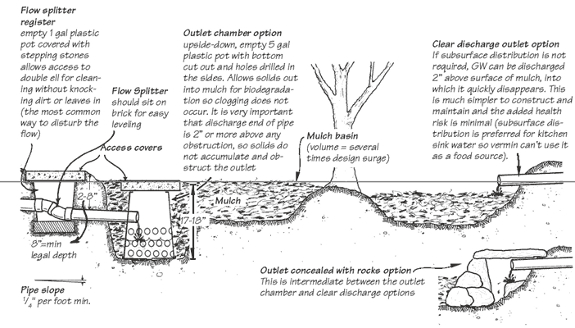Indoor Kitchen Mulch Basin? Solving the On-Site Wastewater Management Problem
Dear Readers,
This blog is short and sweet, because at the moment, ‘tis only an idea. For a refresher on our current ideas and challenges with treating all of our wastewater on-site, check out The Water Petal on our presentation blog. It explains, in depth, the depicted diagram shown below:

Our latest on-site wastewater treatment plan
One of our issues with the above plan is we are unsure on what that filter should be in between our grease trap and indoor greywater garden wall. We have not been able to find any manufactured filter that is willing to treat kitchen water. So, we are being encouraged to get creative, while still adhering to code….
An indoor kitchen mulch basin?
A mulch basin is a basin filled with mulch (woodchips) and a drain at the bottom. When effluent (in our case, kitchen and maybe laundry wastewater) is discharged onto or into the mulch, the mulch catches all of the particles and grease, and allows the water to filter to the bottom and out the drain. I emphasize “onto or into” because some systems have the wastewater being discharged below the ground surface, and then into a mulch basin. This type of subsurface mulch basin is preferred for kitchen waste water due to its desirability to animals (noms, grease).1 For both surface and subsurface mulch basins, bugs naturally find their way to the greasy wood chips, and help break down the organic matter.
The mulch does need to be replaced once a year, and is advised to be disposed of as compost.2 Some people have actually used the old mulch as supplemental chicken feed due to its high protein content!
Example of Greywater Mulch Basins, both subsurface and surface. Credit: waldeneffect.org
All of this thus far sounds like an outdoor endeavor and therefore may not be compatible with PA code on the discharge of wastewater. What WE would like to do, ideally, in The Seed, is to have an indoor mulch basin which would drain the filtered kitchen and laundry water to our indoor greywater garden wall. By keeping the whole treatment of our kitchen and laundry effluent indoors, we should be able to have the system pass code.
So, how would something that requires a lot of mulch and maybe even bugs go into our home? More importantly, where would all of this greasy dirt and waste munching bugs go in our home? And do we really need the bugs?? I have not yet found any examples or case studies of a home or building that has successfully implemented an indoor mulch basin…if anyone has any suggestions, please feel free to comment below!
This is what William is kinda sorta thinking of doing as of now….

What William is currently thinking…
And with that, I think that is a great place to say ‘goodbye’ for now! We’ll let you absorb and ponder that one for a bit.
‘Til next week!!
Shelby Aldrich
1. “Greywater Mulch Basins,” The Walden Effect. 16 August 2012. www.waldeneffect.org/blog/Greywater_mulch_basins/. Accessed on 3 March 2021.
2. “Woodchip Biofilters,” Greywater Action. https://greywateraction.org/woodchip-biofilter-for-kitchen-sink-wetlands/#:~:text=If%20you%20want%20a%20low%20maintenance%20system,%20the,require%20regular%20maintenance%20for%20them%20to%20fuction%20properly. Accessed on 3 March 2021.
4 Comments
Submit a Comment
© 2020 Sustaining Tree
© 2020 Sustaining Tree


Okay 1st thought is access. William will not always be young and in his prime, therefore, I recommend that you access from inside and from up top. As to do you need the bugs? Yes! How? Well, I would suggest every time you clean it out you go out in the woods and get yourself a basket full of leaf mold and throw it in there with the wood chips. Third concept is to look at RV containers made of black vinyl that you could bolt on to the bottom side of a panel that you could usually access from inside the house with a couple of handles; unhook it from that adapter and take the whole thing outside to clean it out wherever you wanna go and then put it back. 4th I’m not sure what that Y adapter is for.
Hello, Mr. Wheatley!! Yes, I do agree, William and I may be in our prime right now, but it will certainly not last forever! And, if we want to make these homes truly accessible and built with prefabrication mindsets, we need to keep these maintenance aspects in mind. Accessing it from the inside and from on top may be an option! It would also allow us to keep a more tightly closed house envelope. William and I will have to see how that would work in our designs.
And the bugs are necessary! Alrighty then 🙂 Do you think it matters what kind of bugs? Or, do you think earthworms will suffice? Or…whatever bugs just happen to be in the leaf mold?
Oh! Hey! RV wastewater holding containers are actually a genius idea…they are about the right shape (narrow and could go under our floor), come in different sizes (perfect for when we figure out what our daily average kitchen/laundry effluent will be), and have wheels! So we really could just unhook the whole thing, wheel it outside, and dispose of our old mulch in our composting area. That. Is an awesome idea. Thank you!!
As for the Y adapter, are you talking about the base of the garden wall? If so, that is so that any greywater that drained through the wall without being absorbed by the plants, can be pumped back up to the top to re-filter through the soil. If that’s not it, let me know!!
Thank you again for reading Mr. Wheatley!! And thank you for the ideas!!! 🙂
William and Shelby,
I recall watching a video of an indoor grey water system that looked like a long water trough full of plants in a solarium.
The homeowner said that it worked great but the local health inspector made him shut it down anyway.
I also thought of the cat tail filtration system that South Middleton Twp. uses to treat waste water near Boiling Springs.
But that does not seem practical for you.
I also found some suggestions on this website for Tiny Homes.
https://thetinylife.com/greywater-systems/
Frank, thank you for the helpful tips! I believe I may have found that video, and what he’s doing sure looked like a simplified version of what we’re hoping to do, I hope our added complexity makes code officials happy. The website you shared is wonderful! A great break down of all the things you need to know to make your system – we may refer back to this as we develop our design and go over details with our local officials, thanks!